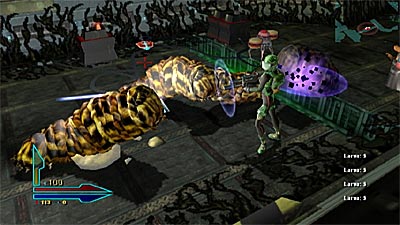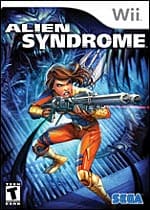Alien Syndrome takes the action RPG genre out of the dungeon and into space with mixed results
Back in the mid-eighties, Alien Syndrome was an addictive run-and-gun quarter-muncher that quickly followed-up its arcade success with multiple PC and console ports, most notably on the Sega Master System. Fast-forward fifteen years, and the kill-it-if-it-moves extraterrestrial shooter returns, shedding new alien blood on our Wiis and PSPs with a re-imagining of the arcade classic.

This Alien Syndrome update puts gamers in the well-worn battle boots of Aileen, a buxom, big-gun-totin’ babe that could teach Alien’s Ripley a thing or two about freeing extraterrestrials of their oozing innards. As the alien-poppin’ protagonist, you’ll traverse countless corridors and large rooms taking out a variety of not-of-this-world life forms, all while upgrading your character and gear with RPG-inspired stats and leveling. Couple these elements with its isometric view of the action, and Alien Syndrome is essentially a Diablo-style dungeon-crawler set in space.
You’ll get plenty of help on your alien-hunting campaign in the form of a hovering cyber pal named SCARAB, who, in addition to offering ranged combat support, is your on-the-go, one-stop-shop for weapon upgrades and other RPG-related goodness, sort of like if you took the helpful shopkeepers and ironsmiths from most fantasy-inspired action RPGS and turned them into a convenient, traveling robo-pal (minus all the ale and wench references, of course.)

Alien Syndrome’s RPG elements are actually a nice touch and a surprisingly addictive addition to the standard shooter formula. Anyone who’s slaughtered countless sewer rats in any number of fantasy-set titles in order to level-up will instantly recognize the “just-a-few-more-experience-points” appeal. Those same gamers may also appreciate the change of scenery, as blasting aliens to upgrade your flamethrower is a refreshing break from killing that umpteenth giant spider so you can finally buy that new broadsword. And speaking of barbequing baddies, Alien Syndrome offers a solid arsenal of upgradeable ranged weapons-from energy and projectile to explosive and flame guns, you’ll have more than enough heavy gear at your disposal to help eliminate the pesky populace. You’ll also have access to a staff-like melee weapon for those more personal encounters. Unfortunately, the Wii-specific motion controls make using this weapon a bit of a chore; specific button presses combined with different motions yield some nice stab, knockdown, and finishing attacks, if you can pull them off. But more often than not you’ll end up an alien appetizer while your Wii-mote flails about hopelessly. Too bad, because the other controls work pretty well-navigating the camera with the Nunchuk while pointing and shooting with the Wii-mote is intuitive and fun, but the alien-blasting buzz is quickly killed when you’re forced to break out the melee maneuvers.

If forcing gamers to swing about like a drunken monkey while trying to stick a finishing move was Alien Syndrome’s only fault, we might be able to look the other way. But sadly, “looking the other way” is exactly what Alien Syndrome’s dated visual presentation will make you do-it looks pretty bad even by the Wii’s lower graphical standards. Judging a title by its looks is a bit harsh; if a game offers some solid fun then who cares what it looks like, right? But, in a console generation offering gamers the alternative to blast aliens in a polygon powerhouse like Gears of War, it’s hard to give Alien Syndrome’s PS1 era presentation a pass. That said, Alien Syndrome is easier on the eyes on the portable PSP version; not in that the graphics are better, but they do seem more at home on Sony’s slick little screen than on a magnified, flaw-revealing television.
Alien Syndrome does manage to redeem some of its shortcomings with an addictive co-op mode supporting up to four adventurers; splattering alien guts is always more fun with friends. Although, we advise tackling the campaign with no more than two players, as four aiming reticules swimming on-screen simultaneously can get a bit dizzying. If you could combine the best elements from both versions-the better melee control and more tolerable graphics on the PSP with the spot-on aiming and sweet cooperative play of the Wii, along with the addictive RPG elements in both titles, you’d have a powerful package. But as it stands, Alien Syndrome’s best qualities are spread thin over two platforms, yielding two average offerings. Co-op fanatics just looking to spend a few baddie-blasting hours with friends will likely get their dollar’s worth from the Wii version, while action RPG addicts looking to get out of the dungeon for awhile might enjoy the PSP’s more single player-friendly presentation. Everyone else should probably just wait for Sega to release a best-of-both-worlds version on Xbox Live Arcade for 800 Microsoft points. C’mon Sega, what do you say?
Features:
|
